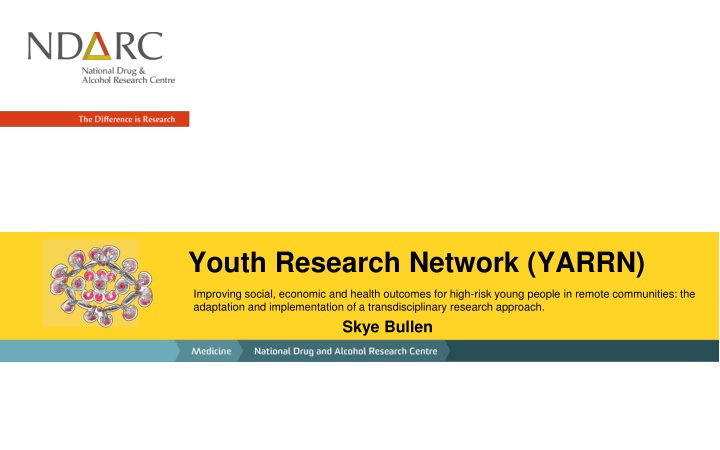
Youth Research Network (YARRN): Improving Outcomes for High-Risk Young People in Remote Communities
Explore how the Youth Research Network (YARRN) aims to enhance social, economic, and health outcomes for high-risk young individuals in remote areas through a transdisciplinary research approach. The project focuses on developing evidence-based models of care and piloting them to reduce juvenile detention rates and improve overall well-being, with potential significant benefits observed. As the research progresses, it aims to generalize effective measures and models across various community-based programs nationwide for sustainable impact.
Download Presentation

Please find below an Image/Link to download the presentation.
The content on the website is provided AS IS for your information and personal use only. It may not be sold, licensed, or shared on other websites without obtaining consent from the author. If you encounter any issues during the download, it is possible that the publisher has removed the file from their server.
You are allowed to download the files provided on this website for personal or commercial use, subject to the condition that they are used lawfully. All files are the property of their respective owners.
The content on the website is provided AS IS for your information and personal use only. It may not be sold, licensed, or shared on other websites without obtaining consent from the author.
E N D
Presentation Transcript
Youth Research Network (YARRN) Improving social, economic and health outcomes for high-risk young people in remote communities: the adaptation and implementation of a transdisciplinary research approach. Skye Bullen
Background Young people exposed to multiple, co-occurring risk factors experience disproportionately high rates of harm, and Indigenous adolescents are over-represented in this population These harms persist over their lifetimes, negatively impacting on their ability to participate meaningfully in society A high proportion of these young people are at very high risk of ending up in juvenile detention, after which their outcomes are much worse The overall aim of our research is to build evidence for community-based services that minimise the number of young people who get sent to juvenile detention 2
Plan for this new research To answer a number of sequential questions (the grey text is research by Alice Knight* and my research is the black text) 1. Can we develop an evidence-based model of care for community-based programs working with high-risk young people? 2. Can we establish a suite of relevant, acceptable measures and embed them into routine service delivery? 3. Can we pilot test this model to establish an initial baseline estimate of how effective it is likely to be, what it costs to deliver, and whether it is a good value for money (economic evaluation)? 4. Can we then generalise the measures and the model of care to similar services nationally, and evaluate its impact across multiple community-based programs? *NB: Anthony Shakeshaft supervised Alice Knight s research with the BackTrack program and was CIA. He is the brother of the Manager and Founder of BackTrack (Bernie Shakeshaft). Supervisor Myf Maple previously provided voluntary and informal research advice to BackTrack. 3
An evidence-based model of care This is the initial model developed. The bolded core components came from Alice Knight s systematic review, the others from the staff of one service It also shows some of the measures (columns d and e) 4
Pilot test does it seem to work? Benefits for participants and the community (yet to be confirmed): Significant reduction in suicide ideation. Almost significant reduction in monthly cannabis use Significant reduction in crime incidents for 15-18 year old males in 2 out of 3 communities Good value for money (likely to be about $3 in savings from less harm for every $1 invested) Now the questions are*: 1. Can we embed the model of care and the measures into community-based programs nationally? 2. Can we demonstrate comparable outcomes across multiple services in multiple communities? *NB: this new project is funded by an ARC Discovery grant 5
New model of care This is the new model that has been tested and amended by staff from services who are participating in the research 6
Indigenous Data Sovereignty (IDS) At present in Australia, Aboriginal people have low control over Indigenous data. We need to progress from the current point to a point where we have high control over our own data. The overall aim is to shift the ownership, control, access and possession (OCAP) of data about Aboriginal people in Australia to Aboriginal people. To do that, we need to understand how OCAP would work in practice what are the principles that should govern how OCAP would work in Australia? How they can be operationalised in practice? My research is looking at the published academic literature to see what sort of principles for OCAP have been proposed in Australia and other countries. The project has embedded current principles intro research practice 7 Reviewing & classifying 78 studies from search. <10 papers that explicitly talk to OCAP principles.



